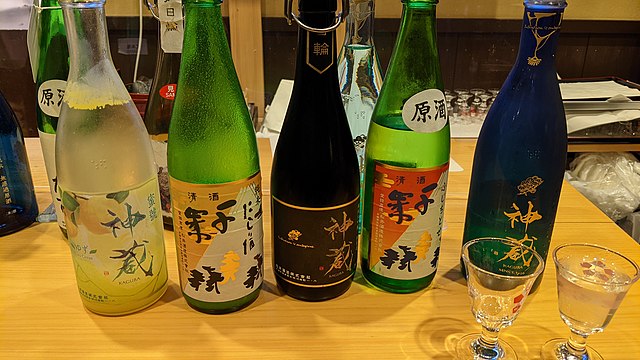Sake on the Rise in America
Why is Sake Japanese rice wine is on the rise in the West.
Nisiguti, CC BY-SA 4.0
Four bottles of Sake from Matsui Brewery
Anime, Hondas, Yuto Horigome, Karate and Dance Dance Revolution. What do these all have in common? They’re all made in Japan and become popular in America. Recently Japanese rice wine also known as Sake has boomed in America. According to this New York times article, exports from Japan have more than doubled in the last decade going from about 14 million liters a year to nearly 36 million liters in 2022.
The Lonely Planet reports that sake is believed to date back to around 5th century B.C.E after cultivating rice was introduced from China. During the Nara period (710-794) however, sake making became more refined and representative of techniques that are still used today. At the time sake was a drink of the Imperial Court, but later sake production was turned over to shrines and temples and then commercial brewers. From the 17th to the 19th centuries sake went from localized businesses to an entire industry with brews flowing into present day Tokyo at an astonishing rate. In the 21st century there is a lot of choice when it comes to alcoholic beverages, but sake’s deeper connection to Japanese cultural and religious practices and a renewed interest with ancient tradition ensures sake’s enduring legacy as time goes on.

In the New York times article, Shinobu Kato first tried sake as a young man in Tokyo, but he hated it. His first experience was with cheaply, poorly made Sake. However, as time passed, and he was introduced to better made styles he grew to love it. When he moved to the United States in 2004, he could afford only bad Sake that had originally left him with a bad impression of Sake overall. In response he decided to brew his own steaming and fermenting rice in his own kitchen. To his pleasant surprise he and his friends loved the sake. Shinobu Kato continued to brew sake after moving to Nashville to work for Nissan. He grew so passionate about sake that, in 2016 with the encouragement of his wife he moved to Brooklyn with the goal of opening his own sake brewery. After buying specialty supplies such as stainless-steel vats, special rice from California, yeast and other necessities from Japan in April 2020 weeks into the Covid lock down, Kato Sake Works opened a small 500-square foot industrial space in Bushwick. He sells various kinds of sake with numerous special batches. Mr. Kato’s timing couldn’t have been better as Sake sales are booming around the work including the United States creating the perfect environment for him to succeed.

The Lonely Planet, reports that the process of making sake has a long history in Japan to the point where the ancient method of making sake is considered a cultural asset. The process of making sake also known as Sake is so well documented that to this day it can be made almost identical to the way it was years ago. The first step is preparing the rice, various kinds of rice are used known as shuzo-kotekimai. This rice is used and milled in a specific way to remove any excess protein from the outer layer which would affect fermentation. This process is known as rice polishing and in general the more rice is polished the better grade and more expensive the sake.

The rice is the washed, soaked, drained and steamed in a vat. The cooled rice is spread out on a long table and a mold is scattered over it converting the starch in the rice into sugar. After two days the rice is ready, and the fermentation can begin. A fermentation starter called Shubo is made when water, the mold and more of the steamed rice is combined in a vat along with cultured yeast. The fermentation starter is then placed in a tank where more steamed rice and water is added over three stages giving the yeast time to multiply in between. After several weeks of fermentation, moromi or “fermentation mash” is pressed to separate the sake from the remaining solids before it’s pasteurized filtered and stored before it is stored before bottling.
Sake’s long and storied history has lead it to become incredibly popular all over the world. Dating all the way back to the 5th century the practice of making Sake has been passed down for generations and has now made it to the Western world.




